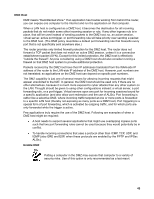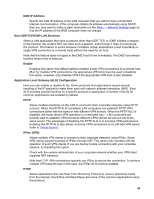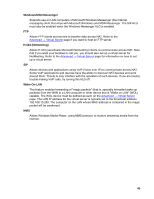TRENDnet TEW-633GR User Guide - Page 44
DMZ IP Address, Non-UDP/TCP/ICMP LAN Sessions, Enable, Application Level Gateway ALG Configuration, - vpn
 |
UPC - 710931600223
View all TRENDnet TEW-633GR manuals
Add to My Manuals
Save this manual to your list of manuals |
Page 44 highlights
DMZ IP Address Specify the LAN IP address of the LAN computer that you want to have unrestricted Internet communication. If this computer obtains its address automatically using DHCP, then you may want to make a static reservation on the Basic → Network Settings page so that the IP address of the DMZ computer does not change. Non-UDP/TCP/ICMP LAN Sessions When a LAN application that uses a protocol other than UDP, TCP, or ICMP initiates a session to the Internet, the router's NAT can track such a session, even though it does not recognize the protocol. This feature is useful because it enables certain applications (most importantly a single VPN connection to a remote host) without the need for an ALG. Note that this feature does not apply to the DMZ host (if one is enabled). The DMZ host always handles these kinds of sessions. Enable Enabling this option (the default setting) enables single VPN connections to a remote host. (But, for multiple VPN connections, the appropriate VPN ALG must be used.) Disabling this option, however, only disables VPN if the appropriate VPN ALG is also disabled. Application Level Gateway (ALG) Configuration Here you can enable or disable ALGs. Some protocols and applications require special handling of the IP payload to make them work with network address translation (NAT). Each ALG provides special handling for a specific protocol or application. A number of ALGs for common applications are enabled by default. PPTP Allows multiple machines on the LAN to connect to their corporate networks using PPTP protocol. When the PPTP ALG is enabled, LAN computers can establish PPTP VPN connections either with the same or with different VPN servers. When the PPTP ALG is disabled, the router allows VPN operation in a restricted way -- LAN computers are typically able to establish VPN tunnels to different VPN Internet servers but not to the same server. The advantage of disabling the PPTP ALG is to increase VPN performance. Enabling the PPTP ALG also allows incoming VPN connections to a LAN side VPN server (refer to Virtual Server). IPSec (VPN) Allows multiple VPN clients to connect to their corporate networks using IPSec. Some VPN clients support traversal of IPSec through NAT. This option may interfere with the operation of such VPN clients. If you are having trouble connecting with your corporate network, try disabling this option. Check with the system administrator of your corporate network whether your VPN client supports NAT traversal. Note that L2TP VPN connections typically use IPSec to secure the connection. To achieve multiple VPN pass-through in this case, the IPSec ALG must be enabled. RTSP Allows applications that use Real Time Streaming Protocol to receive streaming media from the internet. QuickTime and Real Player are some of the common applications using this protocol. 44















